My mother, Marie Iverson is a daughter of Victor Moses Iverson and Leoma McCain, and a granddaughter of Hans Peter Jeppesen and Juliane Johanne Dorthea Christensen, both of whom were born and raised in Denmark. For most of her adult life she was involved in collecting and writing the histories of her parents and their ancestors. She and other members of the Iverson family worked hard to collect and compile the genealogical and historical data of their Danish ancestors. They did the best they could with the resources they had.
She gave copies of those histories to me. I have found that most of the information in them came from family members and very little from vital records. Some of the dates and places were incorrect because of inaccurate memory or lack of knowledge of the event.
There are many confusing things to overcome when an English speaking person does genealogical research in Danish records. The modern English alphabet contains 26 upper and lower case characters. It was first used in the seventh century and came from Latin script. Anciently, Danes used several runic alphabets, which were from Germanic script. Around 1000 AD they began to use Latin script with the same 26 characters as the English alphabet. In 1948 three extra characters were added to give more spelling options to produce sounds that are used in the Danish language, but not in English. The upper and lower case of the three extra characters are listed below.
- Æ - æ: replaced the AE and ae spelling
- Ø - ø: replaced the Oe and oe spelling
- Å - å: replaced the Aa and aa spelling
Part of the confusion that genealogical researchers face is that the three extra characters appear in modern Danish documents but not in the vital records prior to 1948 where most of the research is done. They were not part of the alphabet that my Danish ancestors used.
Some Danish parents gave their children many names, such as my great-grandmother Juliane Johanne Dorthea. It is hard for a researcher to know which of those names she used. Histories written by family members use variations of the names when referring to her. Sometimes the spelling was changed when the transition from Danish to English was made.
Danish surnames are also confusing. For centuries surnames were assigned using the patronymic system. In the Danish version of that system, a male child's surname would be the given name of his father followed by sen
, meaning son of
. Other Scandinavian countries used son
instead of sen. My great-grandfather Hans Peter, the son of Jeppe Iversen was surnamed Jeppesen when he was christened.
In some cases a female child's surname would be the given name of her father followed by datter
, meaning daughter of
. However some female children were surnamed with their father's given name followed by sen, like the male children. By the middle 1800's some Danish parents surnamed all of their children with the father's surname as in done in English speaking people. My great-grandmother Juliane Johanne Dorthea the daughter of Jens Christian Christensen was surnamed Christensen not Jensdatter or Jensen.
Many Danish people changed their surnames when they immigrated to America. Hans Peter's parents, Jeppe and Ane Iversen had two sons surnamed Jeppesen and three daughters surnamed Jeppesdatter. They all joined the Church of Jesus Christ of Latter-day Saints in Denmark. In 1855 all of them but Hans Peter joined other converts to the church and traveled together from Denmark to England to New York. They sailed from Liverpool, England on 12 December 1855 and arrived in New York, United States on 15 February 1856. On the passenger manifest all of their surnames are Iversen, not Jeppesen or Jeppesdater. After their arrival the names were spelled in various ways, such as Eversen, Everson, Iversen and Iverson. Each of these changes added to the difficulty of doing Danish family history research.
From 1793 to 1970 the places in Denmark were arranged into towns, parishes, districts and counties. In 1970 the districts were abolished and some of the counties were merged. FamilySearch accepts Town, Parish (Sogn), District (Herred), County (Amt), Denmark as a standard place name. It also accepts names without the district as standard.
The following information shows the results of my research into the birth and marriages of my great-grandparents Juliene Johanne Dorthea Christensen and Hans Peter Iverson and their parents. I have stated the information as though it is fact. I must acknowledge that not all of it agrees with the data in FamilySearch's Family Tree. The place names are spelled using the alphabet prior to 1948.
To enlarge an image click on it then click again to reduce it.
Hans Peter Jeppesen and His Parents
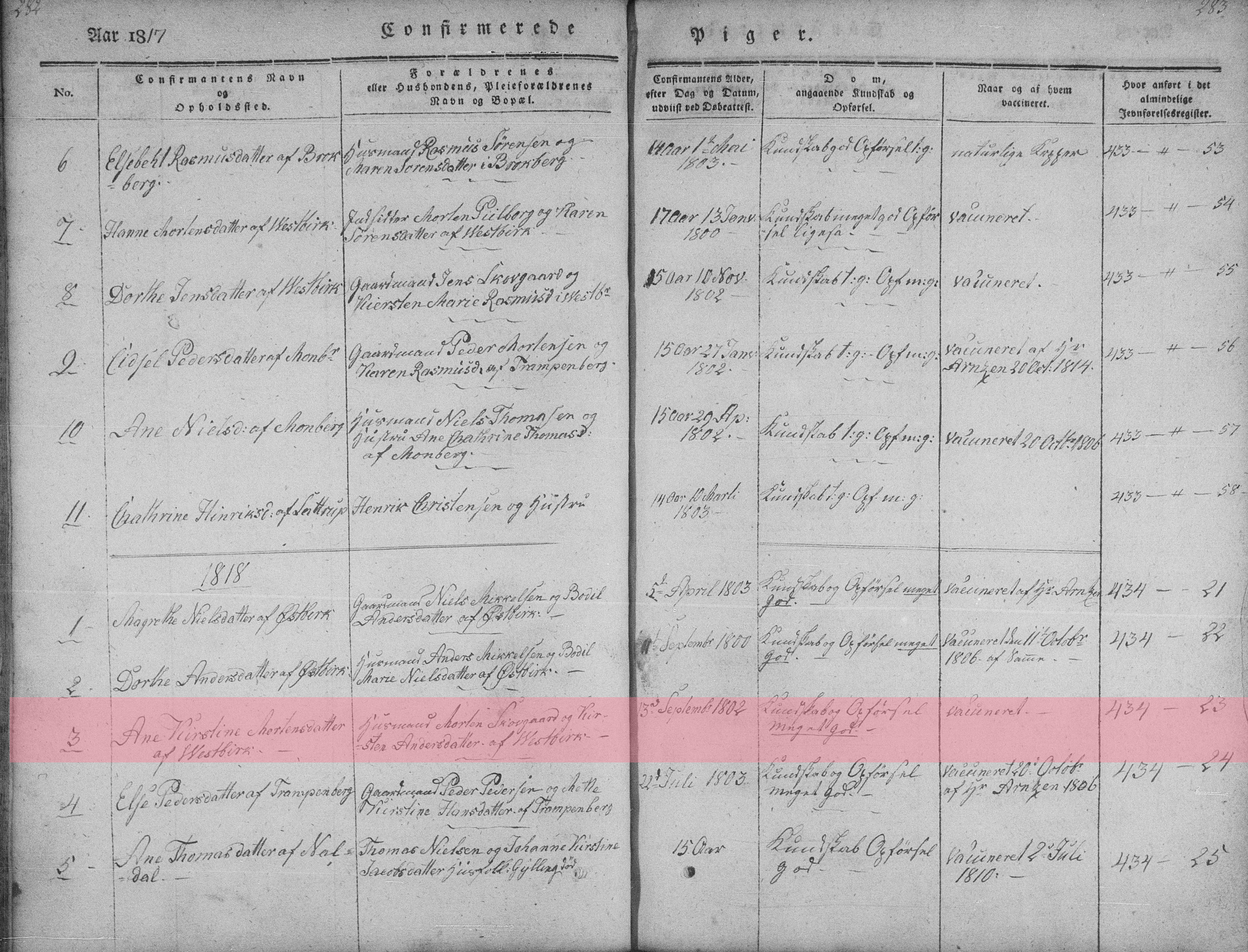 The page from the Ostbirk Parish Register showing the conformation of Ane Kirstine Mortensdatter. The entry is the third in the year 1818 and is shaded in red.
The page from the Ostbirk Parish Register showing the conformation of Ane Kirstine Mortensdatter. The entry is the third in the year 1818 and is shaded in red.
In his autobiography, Hans Peter claims that his mother is Annie Agorstine Mortensen. I have not been able to find any records of an Annie Agorstine Mortensen.
The Hansted, Skanderborg Parish register has an entry of the birth of a female child in the town of Rodved on 13 September 1802. The given names of the child are Ane Kirstine. I was not able to find a surname. The father is listed as Morten Andersen. There is an entry in the Ostbirk, Skanderborg Parish register showing the confirmation in 1818 of an Ane Kirstine Mortensdatter, the child of Morton Skougaard and Kirsten Andersdatter of Vestbirk. In it the birth is given as 13 September 1802.
Since both records have the same given names and the same birth date, it appears that they refer to the same Ane Kirstine. If that is the case, then her family must have left Rodved and moved to Vestbirk in the Ostbirk Parish between 1802 and 1818. I believe that this Ane Kirstine Mortensdatter is Hans Peter's mother.
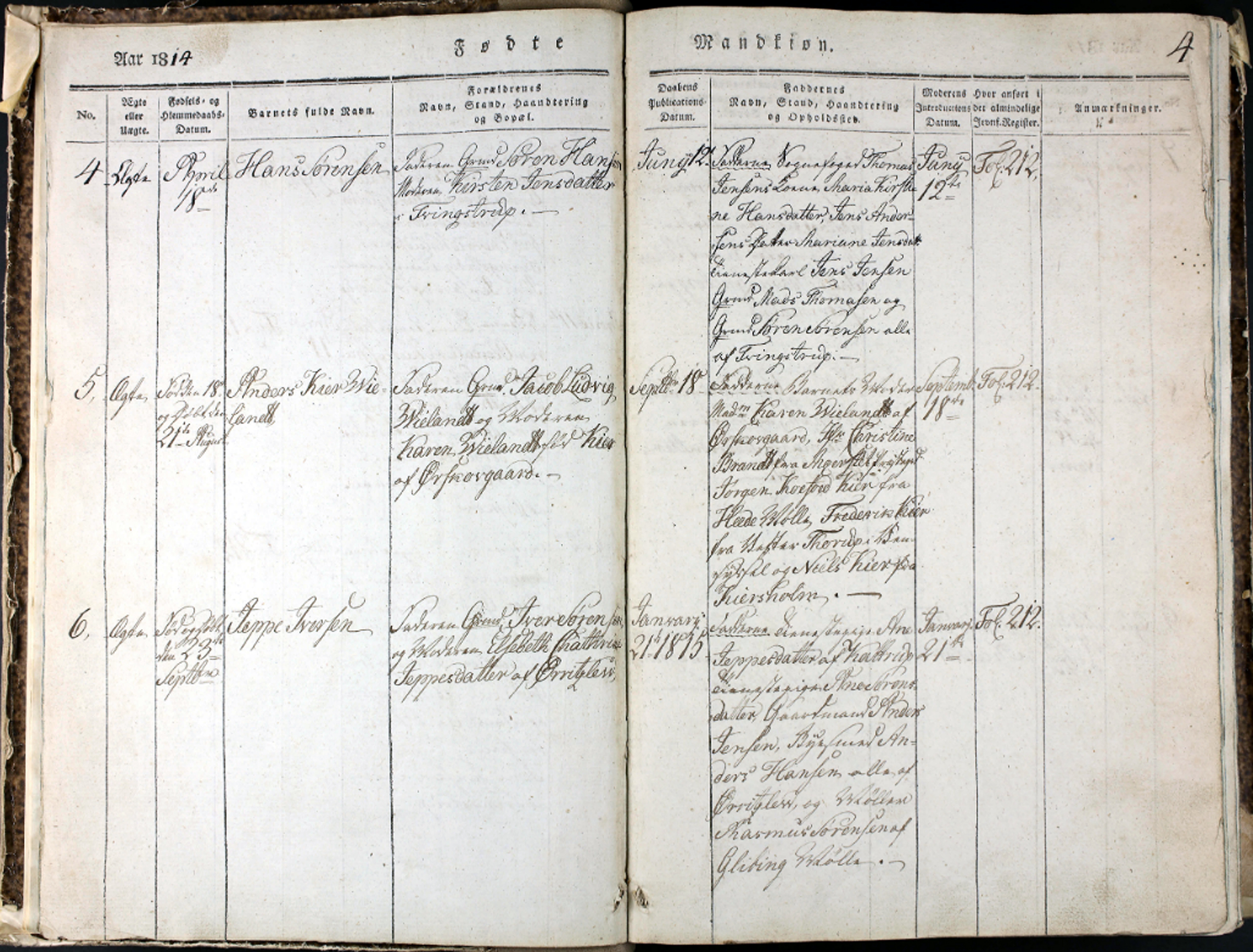 The record of Jeppe Iversen's birth and christening in the Orritslev, Skanderborg Parish.
The record of Jeppe Iversen's birth and christening in the Orritslev, Skanderborg Parish.
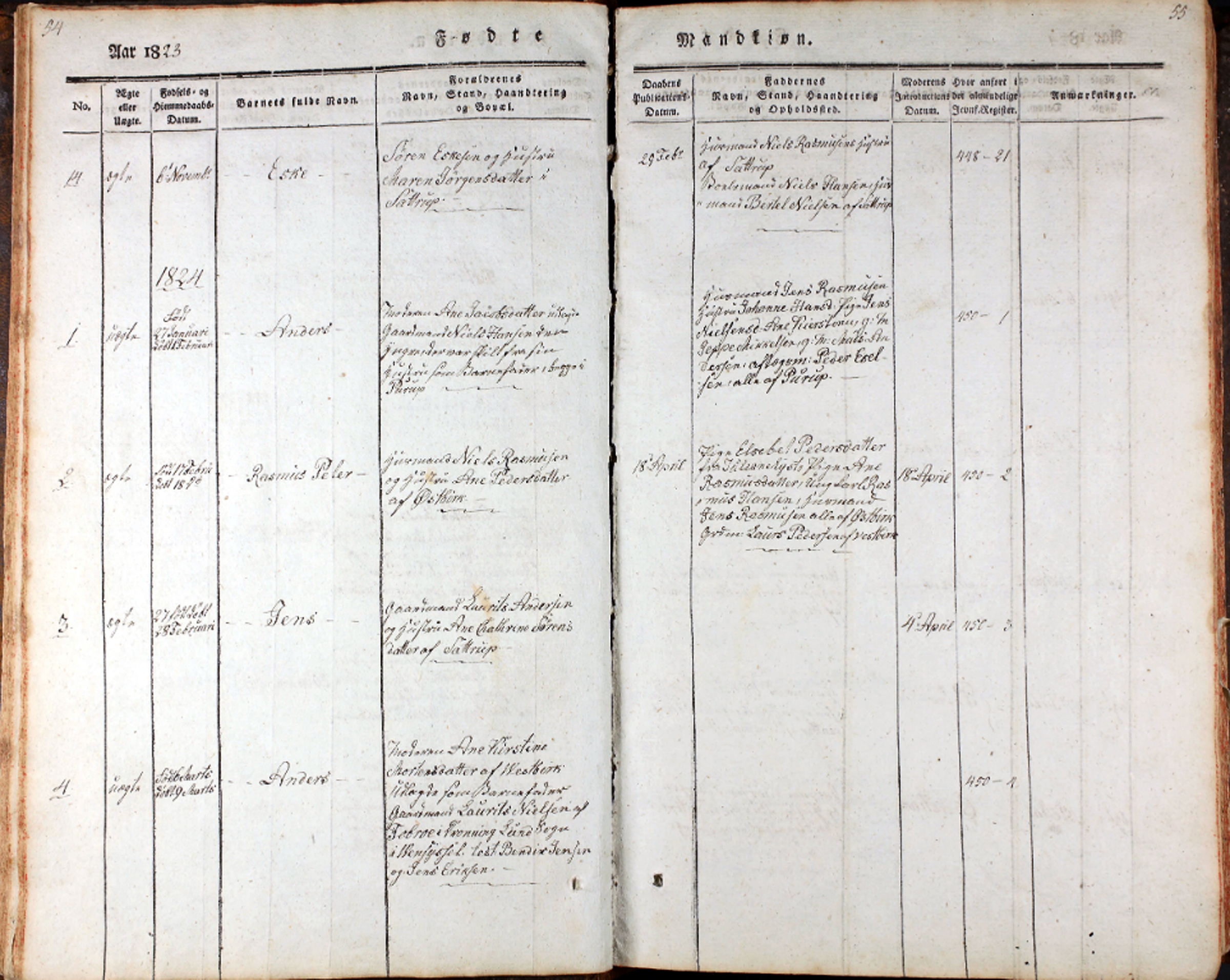 The record of Anders Mortensen's birth and christening in the Ostbirk, Skanderborg Parish.
The record of Anders Mortensen's birth and christening in the Ostbirk, Skanderborg Parish.
Hans Peter's autobiography lists his father as Jeppe Iversen. The Orritslev, Skanderborg Parish register has the record of the birth of a Jeppe Iversen the son of Iver Sorensen and Elizabeth Caterina Jeppsdatter born on 23 September 1814 and christened 21 January 1815 in the parish.
Ane Kirstine Mortensdatter had a sexual relationship with a farmer in her area and had a son out of wedlock in 1824, which she named Anders Mortensen. Apparently the father was not involved with her when Anders was born.
The Ostbirk, Skanderborg Parish register of male births and christenings shows the following pieces of data about Hans Peter Iverson.
- He was born 24 September 1835 in the town of Vestbirk, Skanderborg
- He was christened 22 November, 1835 in the Ostbirk, Skanderborg Parish
- He was given the name of Hans Peter Jeppesen
- His father is Jeppe Iversen of Orridslev, Skanderborg
- His mother is Ane Kirstine Mortensen of Vestbirk
- He was born before his parents were married
Iverson family histories state that Jeppe Iverson and Ane Kirstine Mortensdatter met while he worked for her father, Morton Anderson Skougaard, who had a large farm. Her son, Anders, was living with her. She was 12 years older than Jeppe and her parents were against her marrying Jeppe because of the age difference. They were married on 2 December 1836 in the Ostbirk, Skanderborg Parish. The record says that both were living in Vestbirk, Skanderborg. Apparently Jeppe and Ane lived together before they were married. Hans Peter was born more than a year earlier in 1835 and was given Jeppesen as his surname even though they weren't married.
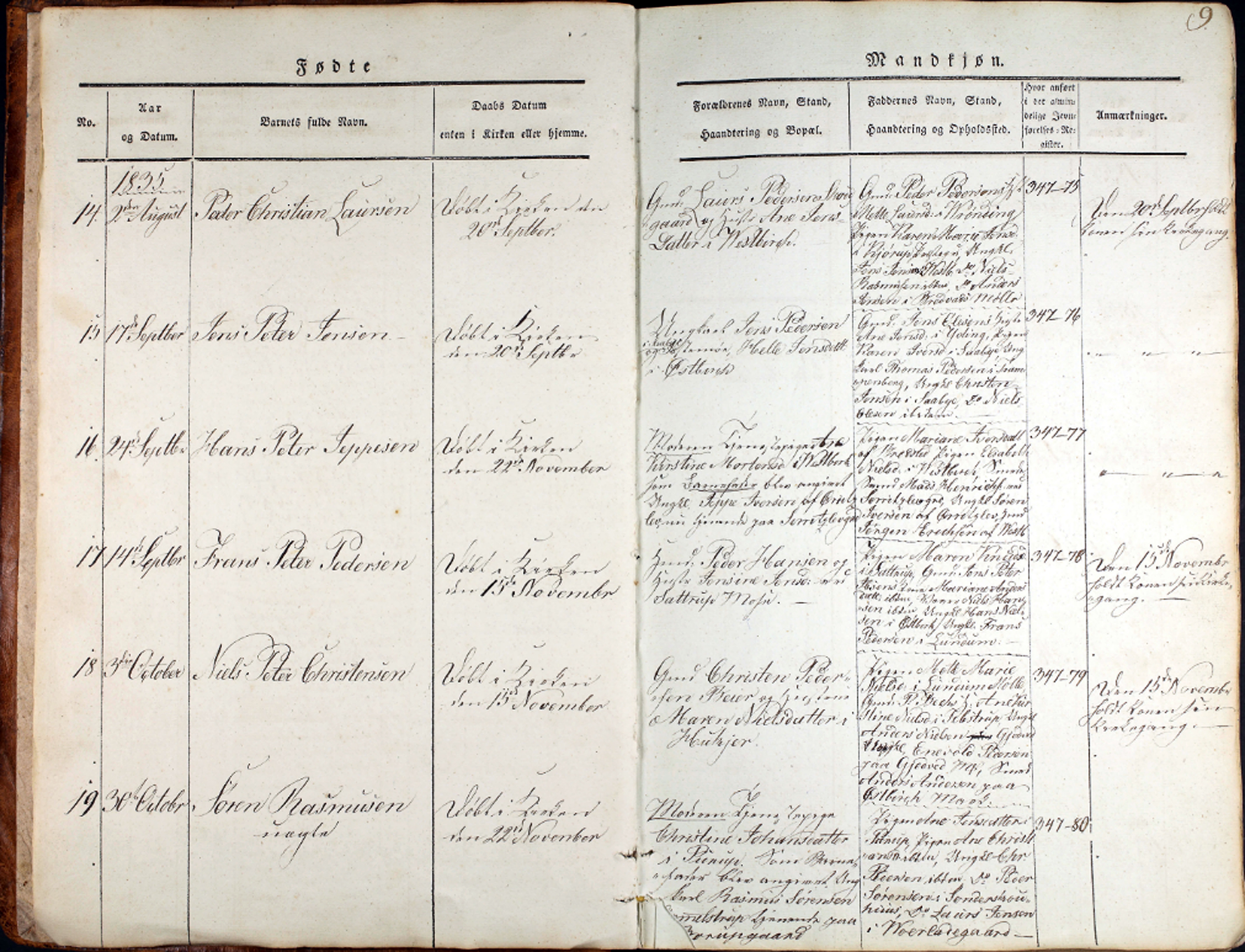 The record of Hans Peter Jeppesen's birth and christening in the Ostbirk, Skanderborg Parish.
The record of Hans Peter Jeppesen's birth and christening in the Ostbirk, Skanderborg Parish.
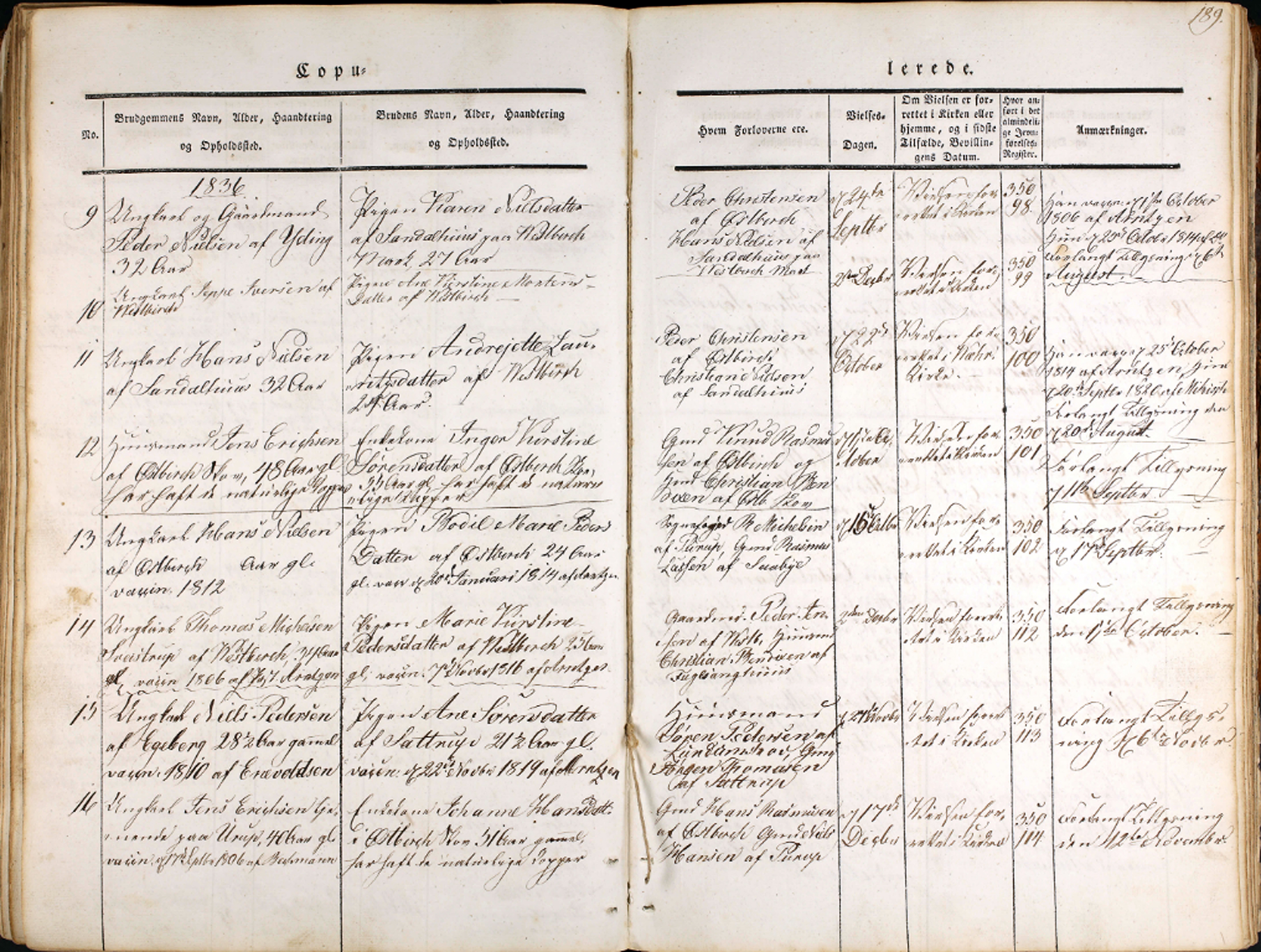 The record of the marriage of Jeppe Iversen and Ane Kirstine Mortensdatter in the Ostbirk, Skanderborg Parish.
The record of the marriage of Jeppe Iversen and Ane Kirstine Mortensdatter in the Ostbirk, Skanderborg Parish.
Juliane Johanne Dorthea Christensen and Her Parents
Hans Peter's second wife is my great-grandmother Juliane Johanne Dorthea Christensen. Her family joined the Church of Jesus Christ of Latter-day Saints while he was on his second mission. She was born 6 February 1859 in Kettrup, Thisted to Jens Christian Christensen and Larsine Marie Petersen Raps.
Juliane's father, Jens Christen Christensen, was born 10 May 1825 in Gunderup, Alborg to Christen Christensen and Maren Jensdatter
Juliane's mother, Larsine Marie Petersen Raps, was born 2 June 1831 in Norresundby, Aalborg, Denmark to Johannes Frederik Petersen Raps and Anne Marie Nielsdatter. She was confirmed in the Danish Lutheren Church in 1846 in the Sundby, Thisted Parish. Notice that She was not surnamed Johannesdatter but Raps, the same as her father.
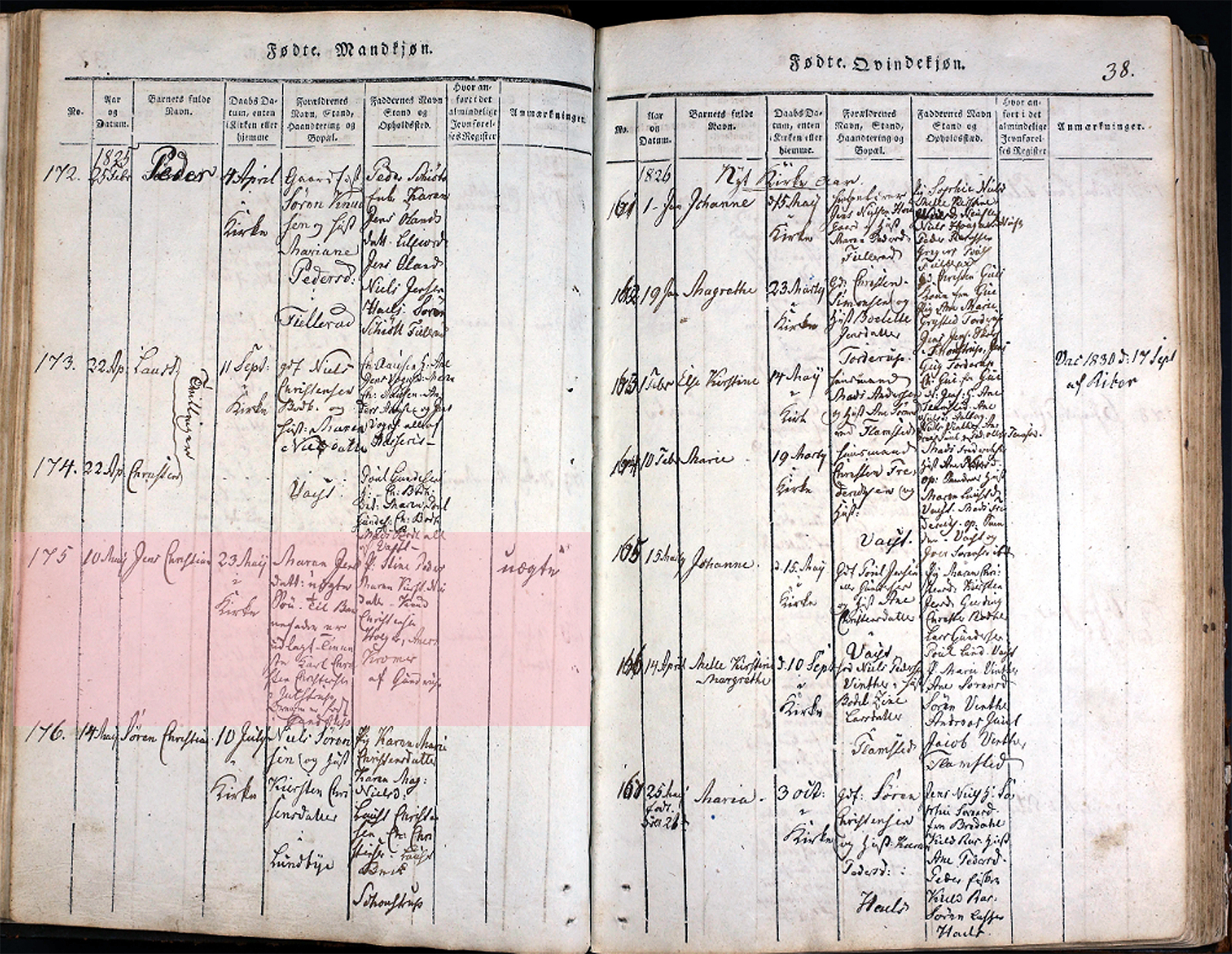 The record of the birth and christening of Jens Christian Christensen in the Gunderup, Aalborg Parish.
The record of the birth and christening of Jens Christian Christensen in the Gunderup, Aalborg Parish.
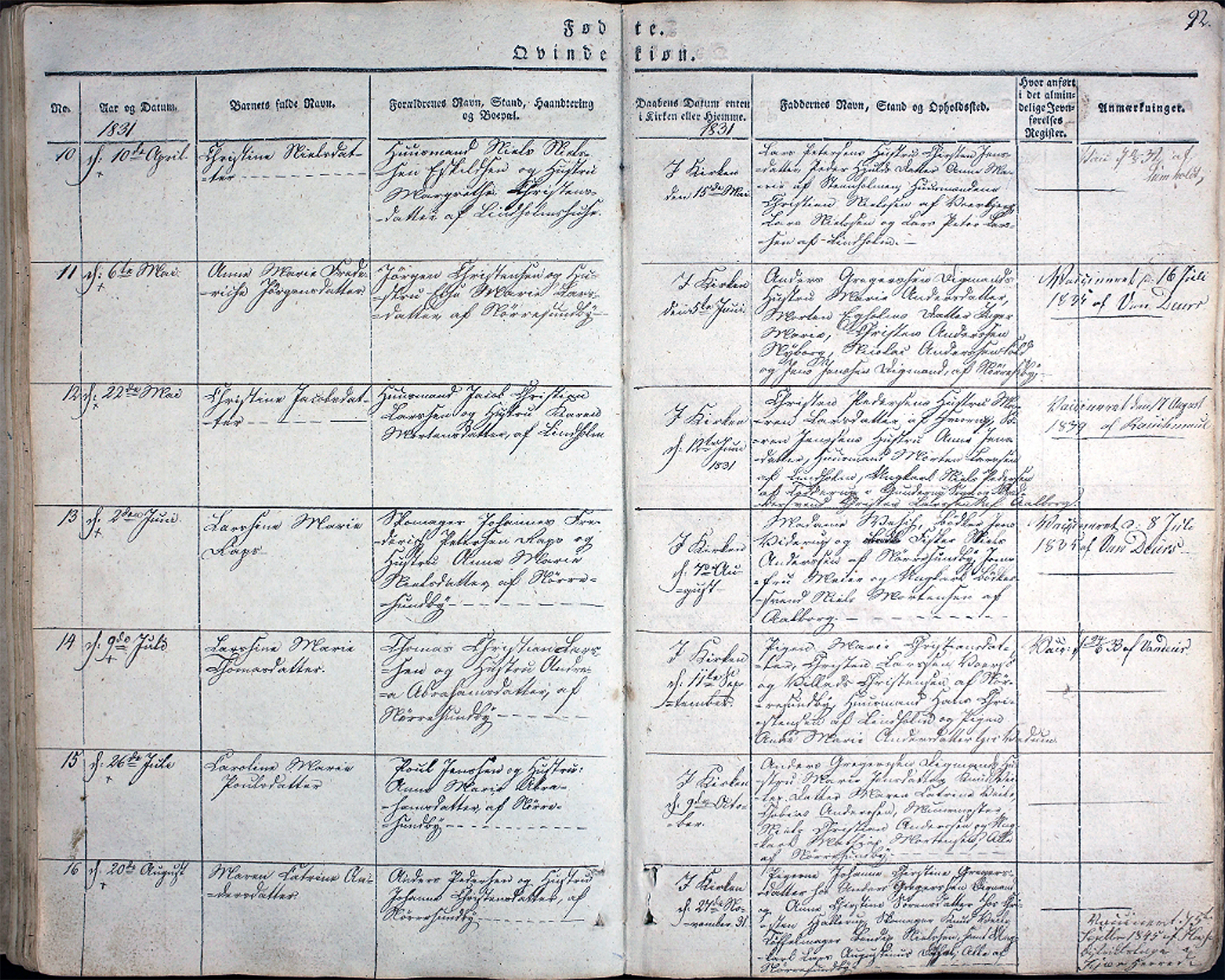 The record of the birth and christening of Larsine Marie Raps in the Norresundy, Aalborg Parish.
The record of the birth and christening of Larsine Marie Raps in the Norresundy, Aalborg Parish.
Jens Christian Christensen and Larsine Marie Raps had a daughter born 26 March 1857 in Hals, Aalborg, before they were married. I have found many other instances where couples lived together and had children before they were married. Jens and Larsine were married 22 August 1857.
Juliane Johanne Dorthea is the second child of Jens and Larsine. She and her four sisters were surnamed Christensen the same as their father.
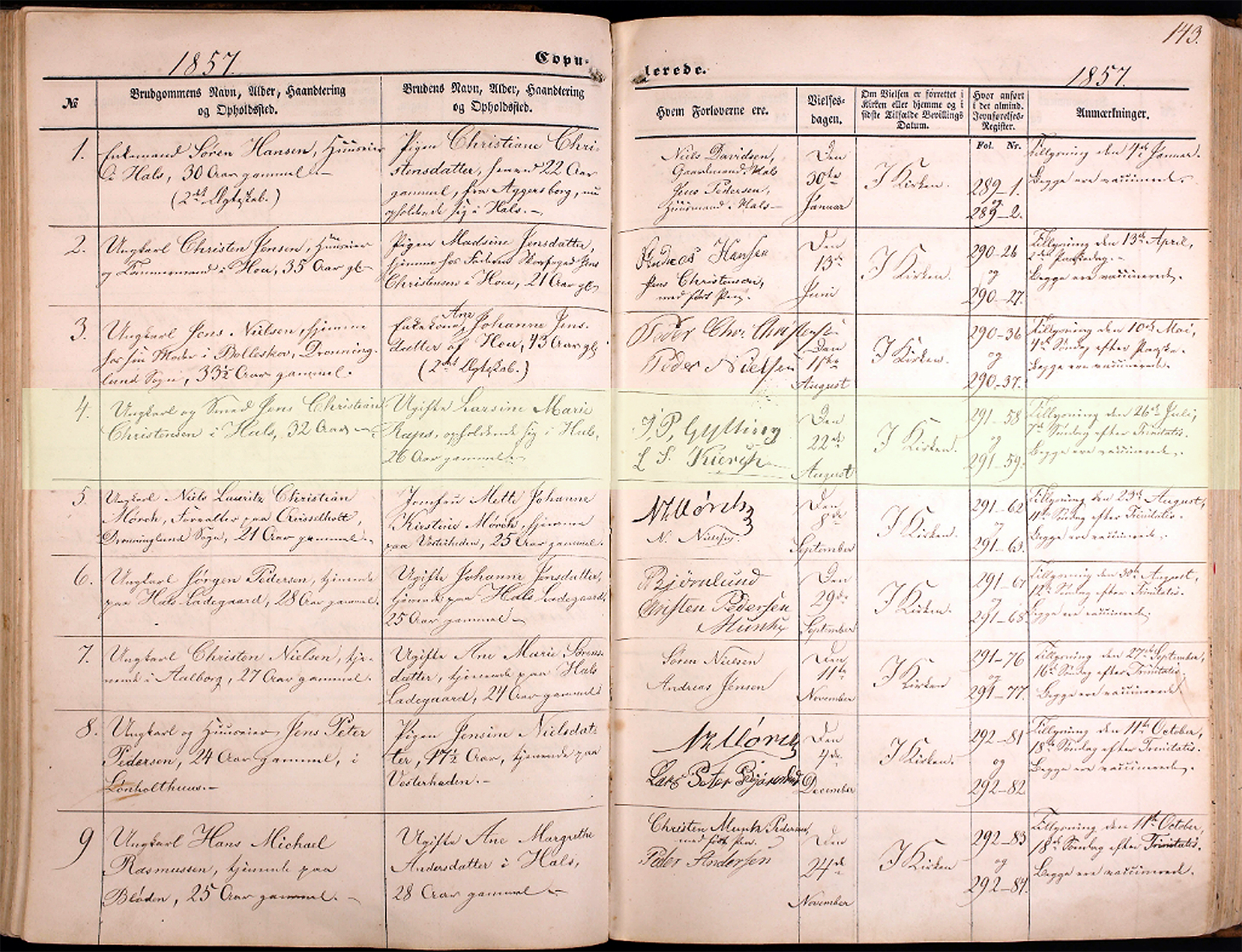 The record of the marriage of Larsine Marie Raps and Jens Christian Christensen in the Hals Aalborg Parish.
The record of the marriage of Larsine Marie Raps and Jens Christian Christensen in the Hals Aalborg Parish.
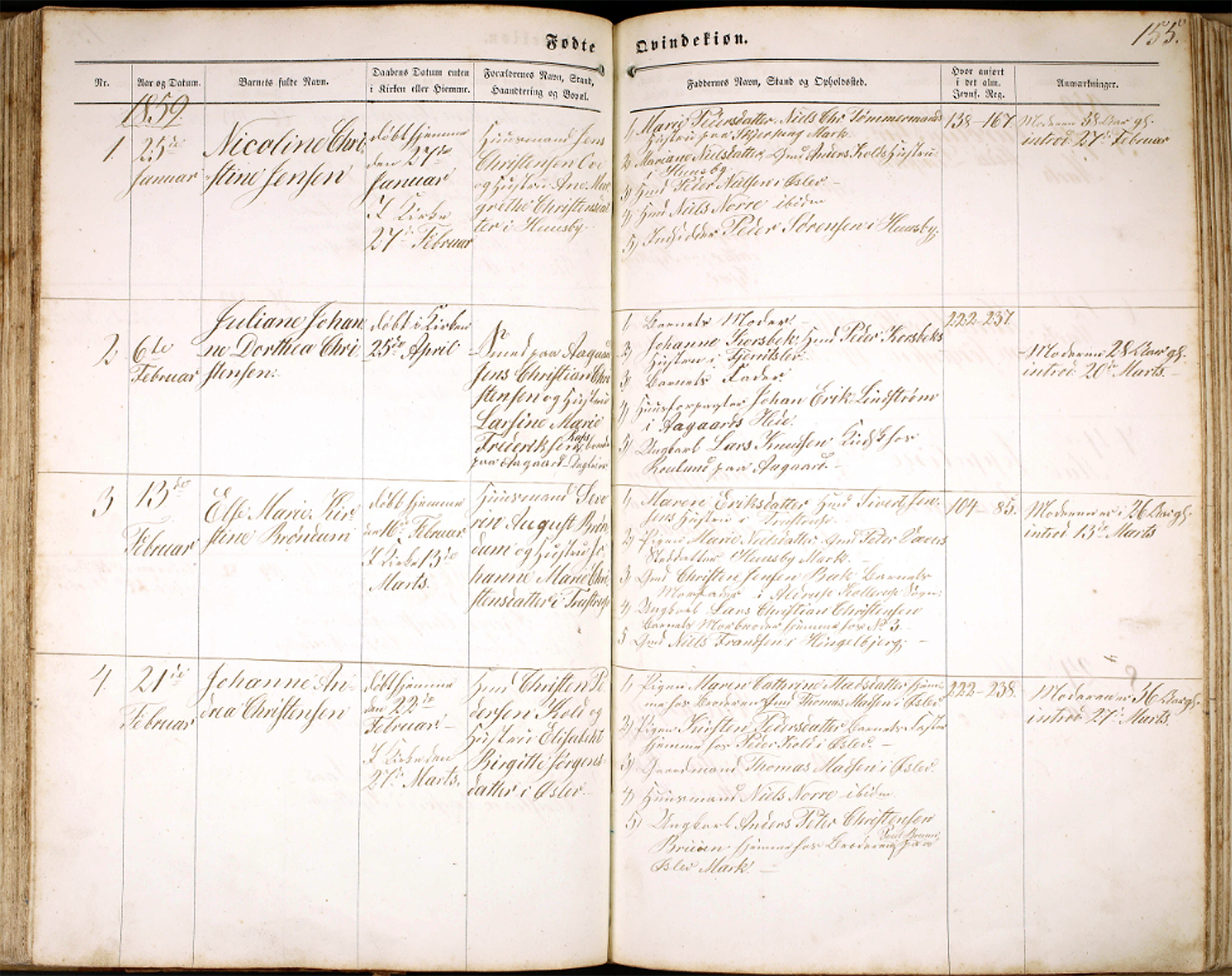 The record of the birth and christening of Juliene Johanne Dorthea Christensen in the Ketterup, Thisted Parish.
The record of the birth and christening of Juliene Johanne Dorthea Christensen in the Ketterup, Thisted Parish.